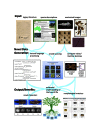Next-generation phenomics for the Tree of Life
- PMID: 23827969
- PMCID: PMC3697239
- DOI: 10.1371/currents.tol.085c713acafc8711b2ff7010a4b03733
Next-generation phenomics for the Tree of Life
Abstract
The phenotype represents a critical interface between the genome and the environment in which organisms live and evolve. Phenotypic characters also are a rich source of biodiversity data for tree building, and they enable scientists to reconstruct the evolutionary history of organisms, including most fossil taxa, for which genetic data are unavailable. Therefore, phenotypic data are necessary for building a comprehensive Tree of Life. In contrast to recent advances in molecular sequencing, which has become faster and cheaper through recent technological advances, phenotypic data collection remains often prohibitively slow and expensive. The next-generation phenomics project is a collaborative, multidisciplinary effort to leverage advances in image analysis, crowdsourcing, and natural language processing to develop and implement novel approaches for discovering and scoring the phenome, the collection of phentotypic characters for a species. This research represents a new approach to data collection that has the potential to transform phylogenetics research and to enable rapid advances in constructing the Tree of Life. Our goal is to assemble large phenomic datasets built using new methods and to provide the public and scientific community with tools for phenomic data assembly that will enable rapid and automated study of phenotypes across the Tree of Life.
Figures
References
-
- Gauthier, J. A., A. Kluge, and T. Rowe. Amniote phylogeny and the importance of fossils. Cladistics 1988; 4:105-209. - PubMed
-
- Lewis, P. O. A likelihood approach to estimating phylogeny from discrete morphological character data. Syst Biol. 2001; 50(6): 913-925. - PubMed
-
- Wiens, J. J. The role of morphological data in phylogeny reconstruction. Syst Biol. 2004; 53:653-661 - PubMed
-
- Losos, J. B., D. M. Hillis, and H. W. Greene. Who speaks with a forked tongue? Science 2012; 338: 1428-1429. - PubMed
-
- O’Leary, M. A., J. I. Bloch, J. J. Flynn, T. J. Gaudin, A. Giallombardo, N. P. Giannini, S. L. Gold-berg, B. P. Kraatz, Z.-X. Luo, J. Meng, X. Ni, M. J. Novacek, F. A. Perini, Z. Randall, G. W. Rougier, E. J. Sargis, M. T. Silcox, N. B. Simmons, M. Spaulding, P. M. Velazco, M. Wek-sler, J. R. Wible, and A. L. Ciranello. The placental mammal ancestor and the post-KPg radiation of placentals. Science 2013; 339:662-667. - PubMed
LinkOut - more resources
Full Text Sources
Other Literature Sources


